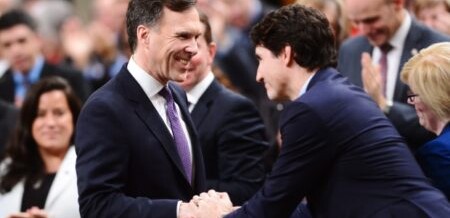
McLeod Group blog by Stephen Brown and Hunter McGill, February 28, 2018
If you watched Finance Minister Bill Morneau’s budget speech in the House of Commons yesterday, you had to be paying close attention to catch the one sentence that refers to foreign aid: “We will also do more to help vulnerable people around the world by making the largest new investments in international assistance in more than a decade, including greater support for the world’s women and girls, through Canada’s Feminist International Assistance Policy.”
The budget document provides the details of the extra money involved: $200 million in additional funding for next fiscal year, rising by $100 million per year until 2022-2023, for a total of $2 billion spread over five years. This is good news and will provide some much-needed resources to support Canada’s Feminist International Assistance Policy, announced last year. It is also much better than last year’s “stingy” budget, which foresaw no increase whatsoever in foreign aid. Budget 2018 can thus be considered a “win” for Minister of International Development Marie-Claude Bibeau and Canadian civil society organizations that campaigned for the government to increase the aid budget.
But how big a win is it? Canada spent only 0.26% of gross national income (GNI) on official development assistance in 2016, a far cry from the international target of 0.7%. How will the injection of $2 billion change this? This coming year’s extra $200 million will provide a bit of a boost, but then the increases of about 2% per year won’t be enough to keep up with the combination of economic growth and inflation, which the budget expects to average 4% annually for the next five years. Soon, Canadian aid will fall back to about 0.26% of GNI, right where we started.
Missing is any mention of Canada’s decades-old commitment to spending 0.7% of GNI on development assistance. Some of Canada’s peers, such as Germany and the United Kingdom, have met that target in recent years. Others, including Norway and Sweden, regularly surpass it. Whereas Canada used to rank among the five or six most generous Western donors, it has now fallen to 15th place. The Canadian government, which brags about how Canada has the best economic situation in the G7, could do a lot more if it wanted to.
The size of the aid budget matters, but of course so does where and how it will be spent. Budget 2018 repeats the main commitments made in last year’s aid policy, including dedicating 95% of bilateral aid to programs that either target gender equality gaps or integrate gender equality goals and the empowerment of women and girls. As Liam Swiss recently argued, it will be a major challenge to achieve these ambitions of the new policy without a major increase in funding, opting instead for what he calls “miserly feminism”, among other concerns. The new budget does little to change this.
The budget plan also reiterates the easy-to-reach goal of increasing the proportion of bilateral aid going to Sub-Saharan Africa from 46% to 50%. As argued by Rachael Calleja, this increase is too small to make much of a difference.
Potentially more significant is the announcement of two “innovative” new programs, to be funded from existing resources, meaning that the $300 million to be spent on them annually over the next five years will be at the expense of other programs. The first, entitled the International Assistance Innovation Program, will “give the Government greater flexibility for financing arrangements and partnerships and ensure Canada remains at the leading edge of development financing”. It is not yet clear what this entails and how this new program relates to Canada’s new Development Finance Institute, about which the McLeod Group has expressed qualms.
The announcement of a Sovereign Loans Program is even more enigmatic. Apparently, the government will require some recipients to repay the assistance they get from Canada. This will mark a return to a practice Canada abandoned decades ago over concerns about unserviceable debt in the developing world. The only rationale provided for this in the budget document is that other donors do it.
A final element worth mentioning is the recognition of the universality of the Sustainable Development Goals, that is, of the fact that Canada is committed to development domestically too. Given the large number of Canadians living in poverty, especially Indigenous people, it is significant that the government is taking steps to ensure that “no one is left behind” at home as well.
The fact that international development barely warranted a mention in the Finance Minister’s speech is emblematic of its low priority on the Canadian government’s agenda. As Morneau highlighted, the aid program will get some new funding, which is a relatively small step in the right direction. The government, however, has struggled to explain why it is unwilling to do more. Despite the government’s claims of leadership on the international stage, frequently cited in the supporting document, Budget 2018 does little to convince Canadians or the rest of the world, especially our developing country partners, of Canada’s commitment to practice what it preaches or to shoulder its share of global obligations.
Photo credit: Sean Kilpatrick, Canadian Press.
